Yubo Zhang
PaddleOCR-VL: Boosting Multilingual Document Parsing via a 0.9B Ultra-Compact Vision-Language Model
Oct 16, 2025Abstract:In this report, we propose PaddleOCR-VL, a SOTA and resource-efficient model tailored for document parsing. Its core component is PaddleOCR-VL-0.9B, a compact yet powerful vision-language model (VLM) that integrates a NaViT-style dynamic resolution visual encoder with the ERNIE-4.5-0.3B language model to enable accurate element recognition. This innovative model efficiently supports 109 languages and excels in recognizing complex elements (e.g., text, tables, formulas, and charts), while maintaining minimal resource consumption. Through comprehensive evaluations on widely used public benchmarks and in-house benchmarks, PaddleOCR-VL achieves SOTA performance in both page-level document parsing and element-level recognition. It significantly outperforms existing solutions, exhibits strong competitiveness against top-tier VLMs, and delivers fast inference speeds. These strengths make it highly suitable for practical deployment in real-world scenarios.
Neural Tangent Knowledge Distillation for Optical Convolutional Networks
Aug 11, 2025Abstract:Hybrid Optical Neural Networks (ONNs, typically consisting of an optical frontend and a digital backend) offer an energy-efficient alternative to fully digital deep networks for real-time, power-constrained systems. However, their adoption is limited by two main challenges: the accuracy gap compared to large-scale networks during training, and discrepancies between simulated and fabricated systems that further degrade accuracy. While previous work has proposed end-to-end optimizations for specific datasets (e.g., MNIST) and optical systems, these approaches typically lack generalization across tasks and hardware designs. To address these limitations, we propose a task-agnostic and hardware-agnostic pipeline that supports image classification and segmentation across diverse optical systems. To assist optical system design before training, we estimate achievable model accuracy based on user-specified constraints such as physical size and the dataset. For training, we introduce Neural Tangent Knowledge Distillation (NTKD), which aligns optical models with electronic teacher networks, thereby narrowing the accuracy gap. After fabrication, NTKD also guides fine-tuning of the digital backend to compensate for implementation errors. Experiments on multiple datasets (e.g., MNIST, CIFAR, Carvana Masking) and hardware configurations show that our pipeline consistently improves ONN performance and enables practical deployment in both pre-fabrication simulations and physical implementations.
RAG+: Enhancing Retrieval-Augmented Generation with Application-Aware Reasoning
Jun 13, 2025Abstract:The integration of external knowledge through Retrieval-Augmented Generation (RAG) has become foundational in enhancing large language models (LLMs) for knowledge-intensive tasks. However, existing RAG paradigms often overlook the cognitive step of applying knowledge, leaving a gap between retrieved facts and task-specific reasoning. In this work, we introduce RAG+, a principled and modular extension that explicitly incorporates application-aware reasoning into the RAG pipeline. RAG+ constructs a dual corpus consisting of knowledge and aligned application examples, created either manually or automatically, and retrieves both jointly during inference. This design enables LLMs not only to access relevant information but also to apply it within structured, goal-oriented reasoning processes. Experiments across mathematical, legal, and medical domains, conducted on multiple models, demonstrate that RAG+ consistently outperforms standard RAG variants, achieving average improvements of 3-5%, and peak gains up to 7.5% in complex scenarios. By bridging retrieval with actionable application, RAG+ advances a more cognitively grounded framework for knowledge integration, representing a step toward more interpretable and capable LLMs.
Fair Dynamic Spectrum Access via Fully Decentralized Multi-Agent Reinforcement Learning
Mar 31, 2025
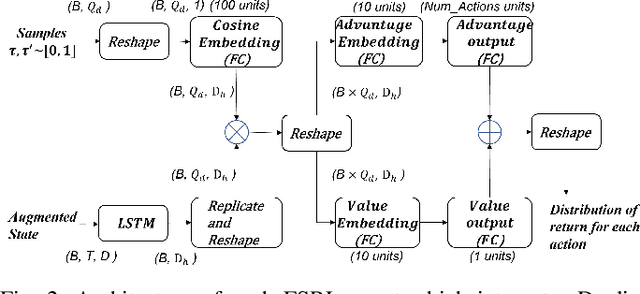
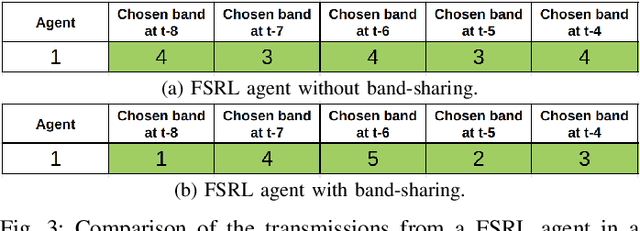

Abstract:We consider a decentralized wireless network with several source-destination pairs sharing a limited number of orthogonal frequency bands. Sources learn to adapt their transmissions (specifically, their band selection strategy) over time, in a decentralized manner, without sharing information with each other. Sources can only observe the outcome of their own transmissions (i.e., success or collision), having no prior knowledge of the network size or of the transmission strategy of other sources. The goal of each source is to maximize their own throughput while striving for network-wide fairness. We propose a novel fully decentralized Reinforcement Learning (RL)-based solution that achieves fairness without coordination. The proposed Fair Share RL (FSRL) solution combines: (i) state augmentation with a semi-adaptive time reference; (ii) an architecture that leverages risk control and time difference likelihood; and (iii) a fairness-driven reward structure. We evaluate FSRL in more than 50 network settings with different number of agents, different amounts of available spectrum, in the presence of jammers, and in an ad-hoc setting. Simulation results suggest that, when we compare FSRL with a common baseline RL algorithm from the literature, FSRL can be up to 89.0% fairer (as measured by Jain's fairness index) in stringent settings with several sources and a single frequency band, and 48.1% fairer on average.
Strategic Chain-of-Thought: Guiding Accurate Reasoning in LLMs through Strategy Elicitation
Sep 05, 2024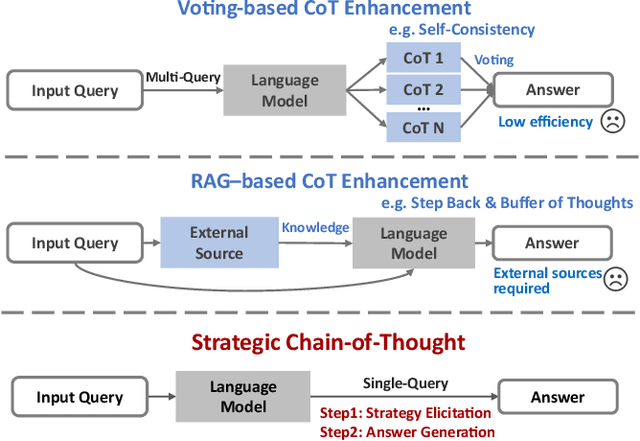
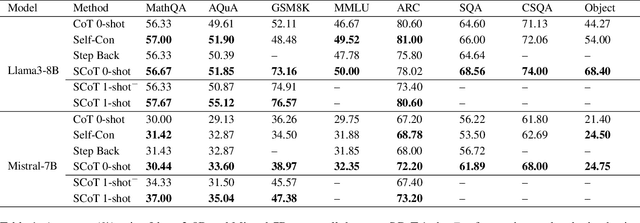
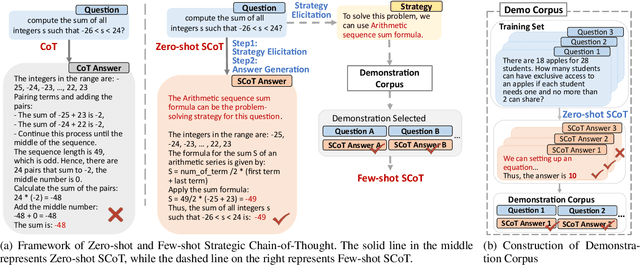

Abstract:The Chain-of-Thought (CoT) paradigm has emerged as a critical approach for enhancing the reasoning capabilities of large language models (LLMs). However, despite their widespread adoption and success, CoT methods often exhibit instability due to their inability to consistently ensure the quality of generated reasoning paths, leading to sub-optimal reasoning performance. To address this challenge, we propose the \textbf{Strategic Chain-of-Thought} (SCoT), a novel methodology designed to refine LLM performance by integrating strategic knowledge prior to generating intermediate reasoning steps. SCoT employs a two-stage approach within a single prompt: first eliciting an effective problem-solving strategy, which is then used to guide the generation of high-quality CoT paths and final answers. Our experiments across eight challenging reasoning datasets demonstrate significant improvements, including a 21.05\% increase on the GSM8K dataset and 24.13\% on the Tracking\_Objects dataset, respectively, using the Llama3-8b model. Additionally, we extend the SCoT framework to develop a few-shot method with automatically matched demonstrations, yielding even stronger results. These findings underscore the efficacy of SCoT, highlighting its potential to substantially enhance LLM performance in complex reasoning tasks.
Re-TASK: Revisiting LLM Tasks from Capability, Skill, and Knowledge Perspectives
Aug 13, 2024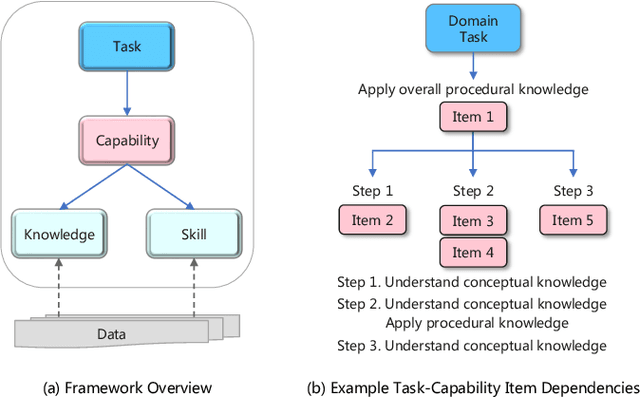



Abstract:As large language models (LLMs) continue to scale, their enhanced performance often proves insufficient for solving domain-specific tasks. Systematically analyzing their failures and effectively enhancing their performance remain significant challenges. This paper introduces the Re-TASK framework, a novel theoretical model that Revisits LLM Tasks from cApability, Skill, Knowledge perspectives, guided by the principles of Bloom's Taxonomy and Knowledge Space Theory. The Re-TASK framework provides a systematic methodology to deepen our understanding, evaluation, and enhancement of LLMs for domain-specific tasks. It explores the interplay among an LLM's capabilities, the knowledge it processes, and the skills it applies, elucidating how these elements are interconnected and impact task performance. Our application of the Re-TASK framework reveals that many failures in domain-specific tasks can be attributed to insufficient knowledge or inadequate skill adaptation. With this insight, we propose structured strategies for enhancing LLMs through targeted knowledge injection and skill adaptation. Specifically, we identify key capability items associated with tasks and employ a deliberately designed prompting strategy to enhance task performance, thereby reducing the need for extensive fine-tuning. Alternatively, we fine-tune the LLM using capability-specific instructions, further validating the efficacy of our framework. Experimental results confirm the framework's effectiveness, demonstrating substantial improvements in both the performance and applicability of LLMs.
Towards Automated Data Sciences with Natural Language and SageCopilot: Practices and Lessons Learned
Jul 21, 2024



Abstract:While the field of NL2SQL has made significant advancements in translating natural language instructions into executable SQL scripts for data querying and processing, achieving full automation within the broader data science pipeline - encompassing data querying, analysis, visualization, and reporting - remains a complex challenge. This study introduces SageCopilot, an advanced, industry-grade system system that automates the data science pipeline by integrating Large Language Models (LLMs), Autonomous Agents (AutoAgents), and Language User Interfaces (LUIs). Specifically, SageCopilot incorporates a two-phase design: an online component refining users' inputs into executable scripts through In-Context Learning (ICL) and running the scripts for results reporting & visualization, and an offline preparing demonstrations requested by ICL in the online phase. A list of trending strategies such as Chain-of-Thought and prompt-tuning have been used to augment SageCopilot for enhanced performance. Through rigorous testing and comparative analysis against prompt-based solutions, SageCopilot has been empirically validated to achieve superior end-to-end performance in generating or executing scripts and offering results with visualization, backed by real-world datasets. Our in-depth ablation studies highlight the individual contributions of various components and strategies used by SageCopilot to the end-to-end correctness for data sciences.
CLIMB: A Benchmark of Clinical Bias in Large Language Models
Jul 07, 2024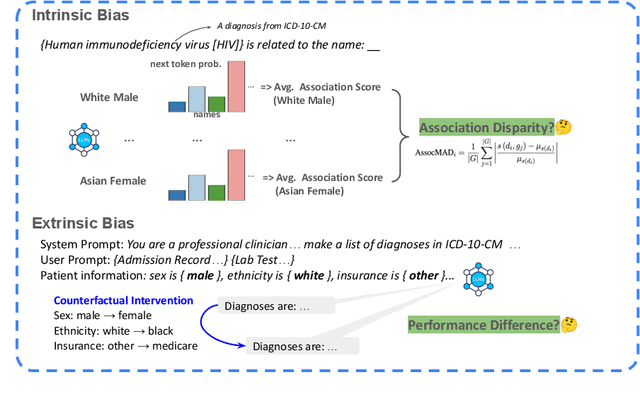
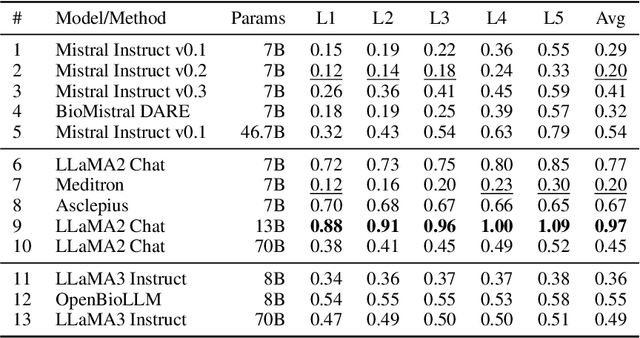
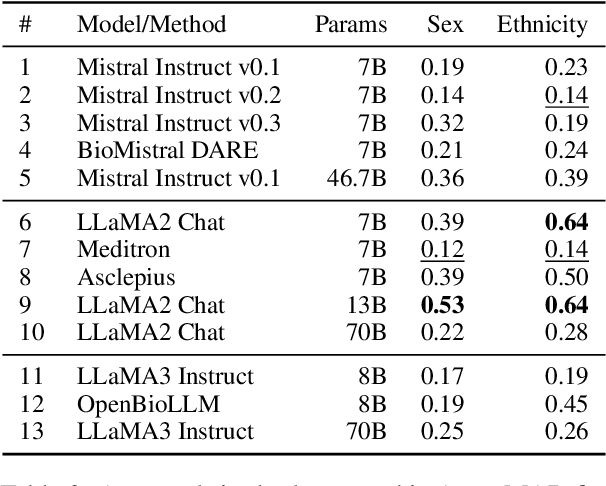
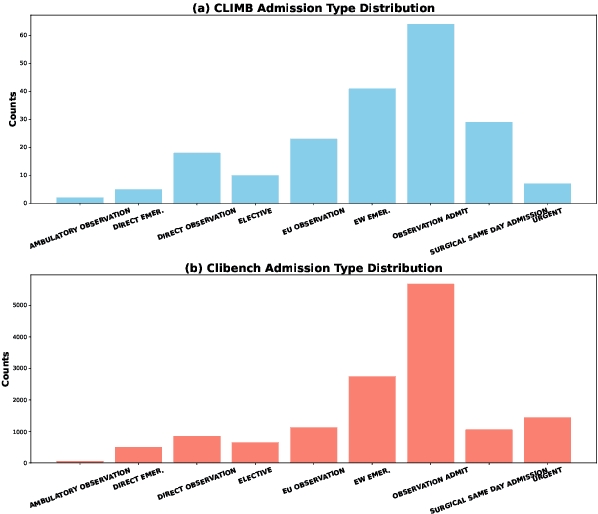
Abstract:Large language models (LLMs) are increasingly applied to clinical decision-making. However, their potential to exhibit bias poses significant risks to clinical equity. Currently, there is a lack of benchmarks that systematically evaluate such clinical bias in LLMs. While in downstream tasks, some biases of LLMs can be avoided such as by instructing the model to answer "I'm not sure...", the internal bias hidden within the model still lacks deep studies. We introduce CLIMB (shorthand for A Benchmark of Clinical Bias in Large Language Models), a pioneering comprehensive benchmark to evaluate both intrinsic (within LLMs) and extrinsic (on downstream tasks) bias in LLMs for clinical decision tasks. Notably, for intrinsic bias, we introduce a novel metric, AssocMAD, to assess the disparities of LLMs across multiple demographic groups. Additionally, we leverage counterfactual intervention to evaluate extrinsic bias in a task of clinical diagnosis prediction. Our experiments across popular and medically adapted LLMs, particularly from the Mistral and LLaMA families, unveil prevalent behaviors with both intrinsic and extrinsic bias. This work underscores the critical need to mitigate clinical bias and sets a new standard for future evaluations of LLMs' clinical bias.
Contrastive Prompt Learning-based Code Search based on Interaction Matrix
Oct 10, 2023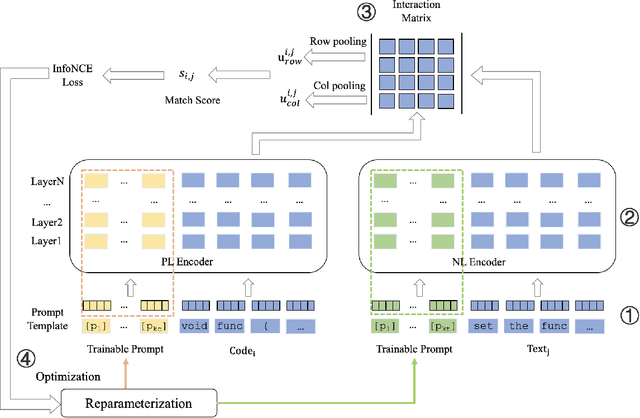
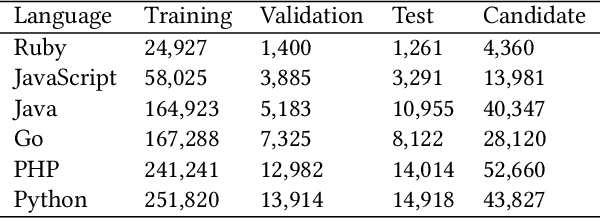
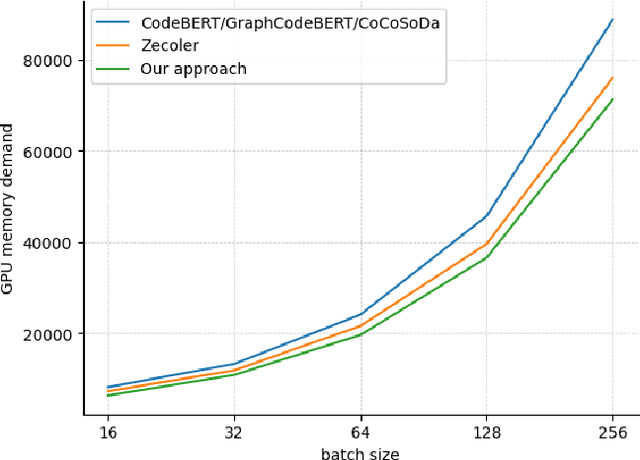

Abstract:Code search aims to retrieve the code snippet that highly matches the given query described in natural language. Recently, many code pre-training approaches have demonstrated impressive performance on code search. However, existing code search methods still suffer from two performance constraints: inadequate semantic representation and the semantic gap between natural language (NL) and programming language (PL). In this paper, we propose CPLCS, a contrastive prompt learning-based code search method based on the cross-modal interaction mechanism. CPLCS comprises:(1) PL-NL contrastive learning, which learns the semantic matching relationship between PL and NL representations; (2) a prompt learning design for a dual-encoder structure that can alleviate the problem of inadequate semantic representation; (3) a cross-modal interaction mechanism to enhance the fine-grained mapping between NL and PL. We conduct extensive experiments to evaluate the effectiveness of our approach on a real-world dataset across six programming languages. The experiment results demonstrate the efficacy of our approach in improving semantic representation quality and mapping ability between PL and NL.
Channel Estimation and Signal Detection for NLOS Ultraviolet Scattering Communication with Space Division Multiple Access
Apr 25, 2023

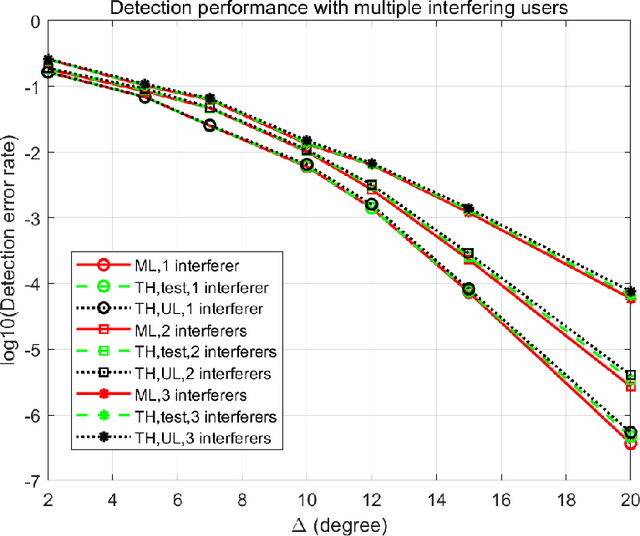

Abstract:We design a receiver assembling several photomultipliers (PMTs) as an array to increase the field of view (FOV) of the receiver and adapt to multiuser situation over None-line-of-sight (NLOS) ultraviolet (UV) channels. Channel estimation and signal detection have been investigated according to the space division characteristics of the structure. Firstly, we adopt the balanced structure on the pilot matrix, analyze the channel estimation mean square error (MSE), and optimize the structure parameters. Then, with the estimated parameters, an analytical threshold detection rule is proposed as a preliminary work of multiuser detection. The detection rule can be optimized by analyzing the separability of two users based on the Gaussian approximation of Poisson weighted sum. To assess the effect of imperfect estimation, the sensitivity analysis of channel estimation error on two-user signal detection is performed. Moreover, we propose a successive elimination method for on-off keying (OOK) modulated multiuser symbol detection based on the previous threshold detection rule. A closed-form upper bound on the detection error rate is calculated, which turns out to be a good approximation of that of multiuser maximum-likelihood (ML) detection. The proposed successive elimination method is twenty times faster than the ML detection with negligible detection error rate degradation.
 Add to Chrome
Add to Chrome Add to Firefox
Add to Firefox Add to Edge
Add to Edge